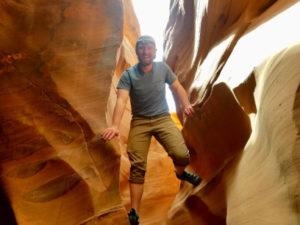 As I awaken in the early morning, I look to the east; the sun just barely peaking over the horizon. The sky is lit with reds, pinks, oranges, and yellows. There is a sweet smell of coffee brewing in my stove. I look off into the distance and wonder about my day to come. What will I see as I canoe down the Green River? How many millions of years’ worth of rock layers will I travel through? What animals will I encounter? I ask these questions because I am practicing natural history. Thomas Fleischner, a professor at Prescott College, defines natural history as “a practice of intentional focused attentiveness and receptivity to the more-then-human world, guided by honesty and accuracy.”
As I awaken in the early morning, I look to the east; the sun just barely peaking over the horizon. The sky is lit with reds, pinks, oranges, and yellows. There is a sweet smell of coffee brewing in my stove. I look off into the distance and wonder about my day to come. What will I see as I canoe down the Green River? How many millions of years’ worth of rock layers will I travel through? What animals will I encounter? I ask these questions because I am practicing natural history. Thomas Fleischner, a professor at Prescott College, defines natural history as “a practice of intentional focused attentiveness and receptivity to the more-then-human world, guided by honesty and accuracy.”
“The fact that we have to make an intentional effort to practice natural history says a lot about the disconnect of our species” (WRFI instructor James Mauch, 2018). The average worker must make time to explore nature. But, do they make the time? Do you? Do you take the time to be observant enough to wonder about what is happening around you? If you don’t, you should; it’s worth every second you put into it. Sometimes you can discover something magical like I did.
A long day has passed as we paddle into camp. A brand-new camp, not only to us students, but to the instructors as well. Nobody has been at this camp in a very long time. This is evident because the footsteps in the sand are covered in rain drop impressions, it hasn’t rained in a month. There are two cottonwood trees just close enough together where I put up my hammock to sleep for the night. I take a seat and admire the evening light reflecting off the west-facing Navajo sandstone canyon wall. Never will a canyon wall look so beautiful as it does in the light of a setting sun. As I sit in my hammock drinking hot cocoa and finish my readings, the sun has fully set to reveal the blanket of stars shining in the dark sky. I gaze at the sky for a few minuets then snuggle into my sleeping bag and lay for the night. I have nothing but the sound of silence as I finally start to fall asleep. Then there is a noise. I am awoken with the sound of heavy wings flapping no more then perhaps a few feet away. I can tell this bird is large; is it going to land on me? It lets out a cry so loud and so edgy, that I can only think a pterodactyl is about to land on me. It’s time to investigate. I emerge from my slumber and look around. I don’t see anything. Another cry, this time louder and scarier. I look up and see the shadow of a Great Blue Heron. This is a bird I’m familiar with in the Midwest, but the desert? In a nest?
To think if I didn’t take the time to observe what was happening around me, I wouldn’t have known that Great Blue Herons lived in the desert. Herons are dependent of aquatic ecosystems, so I figured a desert, where there is limited water, wouldn’t house a bird like the Great Blue Heron. I now know that riparian areas, like the narrow strip along the Green River, are the exception. It is experiences like this that encourage me to practice natural history. Because the practice of natural history helps us connect with the environment around us, everyone should take the time to observe their surroundings. So, I encourage you to eat your lunch outside, go for a walk in the park, or just take a minute to stand outside your front door and use all your senses to cultivate your sense of wonder.